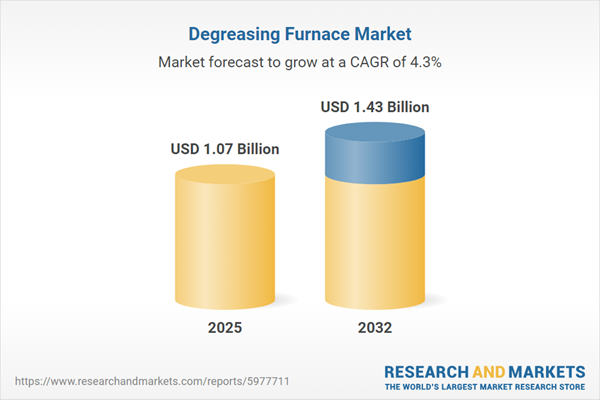Speak directly to the analyst to clarify any post sales queries you may have.
The degreasing furnace market is evolving rapidly as automation, sustainability demands, and complex supply chain challenges reshape industry strategies. Senior executives face mounting pressure to address regulatory changes, align investments, and ensure resilient operations for ongoing business success.
Market Snapshot: Degreasing Furnace Market Growth Dynamics
The global degreasing furnace market is expanding steadily, projected to increase from USD 1.02 billion in 2024 to USD 1.07 billion in 2025 and anticipated to reach USD 1.43 billion by 2032. This trajectory reflects a compound annual growth rate (CAGR) of 4.27%. Growth is driven by the need to meet heightened industrial cleanliness standards, ongoing investments in advanced thermal processing, and progressive regulatory policies. Suppliers and manufacturers are intensifying their focus on energy-efficient solutions, ensuring compliance with international regulations and strengthening their sustainability credentials while maintaining production reliability and process transparency.
Scope & Segmentation: Crucial Factors for Strategic Decision-Making
- Industry Applications: Degreasing furnace systems are central to aerospace, automotive, electronics, and oil and gas sectors. They guarantee precise component preparation and uphold reliability requirements demanded by global supply chains.
- Furnace Types: Batch, belt, conveyor, and tunnel furnaces address diverse operational needs, offering scalability from custom manufacturing lines to high-volume industrial environments.
- Heat Source Options: Electric, gas-fired, and induction units allow organizations to match technology with energy management goals while enhancing emissions reduction efforts and aligning with evolving sustainability targets.
- Automation Levels: Solutions span manual, semi-automatic, fully automated, SCADA-integrated, and robotics-enabled systems. These options enable process accuracy and support labor optimization, particularly vital during workforce shifts.
- Regional Coverage: The Americas, Europe, Middle East and Africa, and Asia-Pacific all exhibit significant demand, with unique adoption drivers in the United States, Germany, China, and India—ranging from infrastructure maturity to shifting investment landscapes.
- Leading Companies: Ipsen International GmbH, SECO/WARWICK Corporation, ALD Vacuum Technologies GmbH, ECM USA Inc., Nordson Corporation, Aichelin Group, Tenova LOI Thermprocess, Thermcraft Inc., Grieve Corporation, and Wisconsin Oven Corporation deliver tailored solutions that address varying regulatory requirements and dynamic operational demands.
Key Takeaways: Strategic Insights for Market Leadership
- Deployment of advanced automation and control platforms increases process reliability, standardizes outcomes, and ensures infrastructures are scalable as operational needs evolve.
- New furnace technologies are focused on resource optimization, integrating features such as hybrid heating and energy recovery to support compliance with emerging operational regulations and sustainability benchmarks.
- Modular designs enhance manufacturing agility, allowing rapid adaptation of plant layouts and capacity in response to shifting business priorities or volatile demand cycles.
- Procurement and risk mitigation strategies strengthen supply continuity, particularly as compliance requirements for documentation and system upgrades intensify in response to new regulatory standards.
- Collaboration with original equipment manufacturers (OEMs) and technical partners accelerates the use of advanced materials and enhances equipment oversight through improved monitoring and lifecycle management practices.
- Resilient supply chains are achieved by robust forecasting and diversifying supplier networks, empowering organizations to better manage variability in material supply and mitigate cost pressures.
Tariff Impact: Navigating U.S. Supply Chain Realities
Recent adjustments to U.S. tariffs have led furnace manufacturers to re-evaluate sourcing models and forge new supplier relationships. These shifts contribute to a greater emphasis on nearshoring, deeper vertical integration, and agile pricing strategies. Collectively, these measures improve supply chain resilience and maintain operational reliability despite continuous regulatory change.
Methodology & Data Sources
Findings in this report are based on secondary research, analysis of technical documentation and patents, and direct interviews with equipment suppliers and system integrators. Industry panels, quantitative modelling, and SWOT frameworks underpin all insights, aligning results with executive strategic goals.
Why This Report Matters: Executive-Level Value
- Supports targeted capital allocation by connecting investment decisions with evolving compliance and operational requirements in the degreasing furnace market.
- Provides practical technology integration and process optimization guidance, enabling senior leaders to synchronize procurement, innovation, and risk management strategies.
- Enables proactive adaptation to industry shifts by recommending automation, advanced materials, and tailored supply chain models responsive to regional and regulatory conditions.
Conclusion
This report delivers data-driven clarity and actionable recommendations to help executive teams prioritize technology and sourcing decisions, maintain compliance, and ensure future-ready operations in the evolving degreasing furnace landscape.
Additional Product Information:
- Purchase of this report includes 1 year online access with quarterly updates.
- This report can be updated on request. Please contact our Customer Experience team using the Ask a Question widget on our website.
Table of Contents
3. Executive Summary
4. Market Overview
7. Cumulative Impact of Artificial Intelligence 2025
Companies Mentioned
The companies profiled in this Degreasing Furnace market report include:- Ipsen International GmbH
- SECO/WARWICK Corporation
- ALD Vacuum Technologies GmbH
- ECM USA Inc.
- Nordson Corporation
- Aichelin Group
- Tenova LOI Thermprocess
- Thermcraft, Inc.
- Grieve Corporation
- Wisconsin Oven Corporation
Table Information
| Report Attribute | Details |
|---|---|
| No. of Pages | 192 |
| Published | October 2025 |
| Forecast Period | 2025 - 2032 |
| Estimated Market Value ( USD | $ 1.07 Billion |
| Forecasted Market Value ( USD | $ 1.43 Billion |
| Compound Annual Growth Rate | 4.2% |
| Regions Covered | Global |
| No. of Companies Mentioned | 11 |









